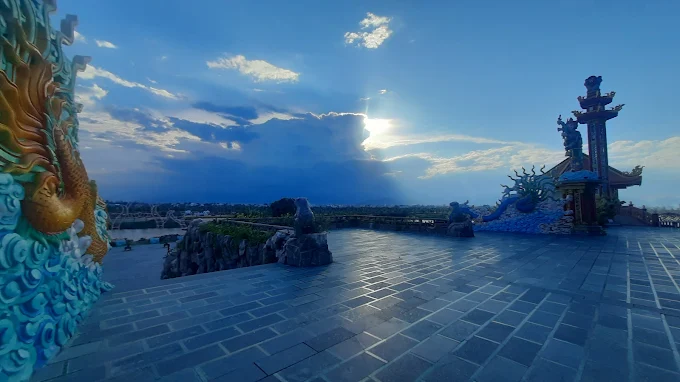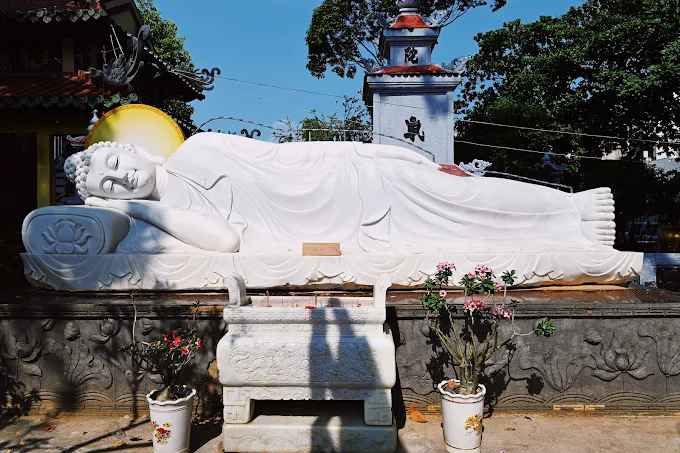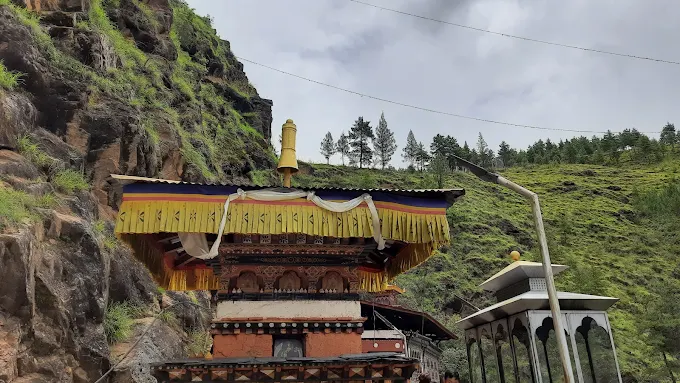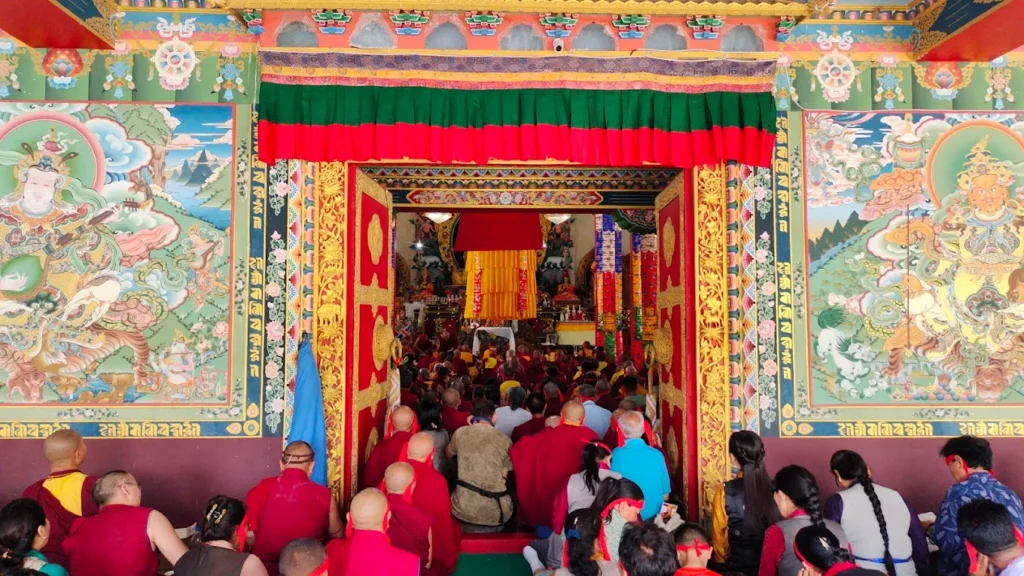Quan Am Pagoda: The Cultural Beacon of Mahayana Compassion
As twilight cloaks Đà Nẵng’s Ngũ Hành Sơn District, Quan Am Pagoda glows, its main hall alive with the serene Avalokitesvara statue, a symbol of compassion inspired by a sacred rock formation. The air hums with Amitabha chanting, devotees seeking rebirth in Amitabha’s Western Paradise, their voices blending with sandalwood incense and the murmur of Quan The Am Festival preparations. A lotus bloom sways in the courtyard’s tranquil pond, reflecting the pagoda’s ornate roof, a masterpiece of Vietnamese artistry. This Mahayana sanctuary, home to the Da Nang Museum of Buddhist Culture, invites all to immerse in Vietnam’s vibrant Buddhist heritage.
Overview and Significance
Introduction to Quan Am Pagoda
Quan Am Pagoda, nestled at 48 Sư Vạn Hạnh in Ngũ Hành Sơn District, stands as a revered Mahayana Buddhist temple, its iconic Avalokitesvara statue and Da Nang Museum of Buddhist Culture embodying the compassion of the Pure Land tradition, which centers on devotion to Amitabha Buddha for rebirth in his Western Paradise. Located 8 kilometers from Đà Nẵng’s city center, this 1957-founded gem blends East Asian elegance with Vietnamese architectural designs, hosting the national intangible cultural heritage Quan The Am Festival. Its main hall, vibrant festival, and unique museum make it a cultural beacon, drawing pilgrims, scholars, and festival-goers into a realm of spiritual and cultural unity.
Historical Journey
Founded in 1957 by Venerable Phap Nhan, Quan Am Pagoda emerged as a spiritual haven for Đà Nẵng’s Mahayana community, inspired by a sacred Avalokitesvara-shaped rock formation discovered in Quan Am Cave. Built with community donations, it became a center for worship and cultural preservation, establishing the Da Nang Museum of Buddhist Culture, Vietnam’s only such museum, in the 1990s. Expansions in the 2000s added meditation halls and enhanced festival grounds, cementing its status as a pilgrimage site.
Through Đà Nẵng’s growth, the pagoda has remained a cultural anchor, its history reflecting a blend of spiritual devotion and heritage preservation.
- Patronage: Supported by local Mahayana Buddhists and Vietnam Buddhist Sangha.
- Milestones: Founded in 1957; museum established in 1990s; expanded in 2000s.
Cultural Significance
Quan Am Pagoda is a vital hub for Đà Nẵng’s Mahayana community, nurturing devotion to Avalokitesvara and Shakyamuni Buddha. Its Pure Land practices, centered on Amitabha chanting, offer solace to devotees and artisans of the nearby Non Nuoc stone carving village. As the headquarters of the Da Nang Museum of Buddhist Culture, it hosts the Quan The Am Festival, a national intangible cultural heritage event on the 19th day of the second lunar month, drawing thousands.
Regionally, it connects with Mahayana communities in Vietnam, sharing Pure Land teachings. Globally, it attracts scholars studying Vietnamese Buddhist artifacts and pilgrims drawn to its festival, offering a glimpse into Mahayana’s compassion.
- Mahayana Hub: Preserves Pure Land practices in Đà Nẵng.
- Cultural Role: Hosts Quan The Am Festival and museum exhibits.
- Global Appeal: Attracts scholars and pilgrims for its museum and festival.
Unique Legacy
The pagoda’s Avalokitesvara statue and Da Nang Museum of Buddhist Culture define its legacy, embodying Mahayana’s compassion. The statue, inspired by a sacred cave formation, and the museum’s rare artifacts symbolize cultural preservation. Vietnamese lotus motifs and festival traditions reflect Mahayana syncretism, while statues like Shakyamuni Buddha anchor spiritual devotion.
This fusion of spiritual statues, cultural heritage, and vibrant festivals earns Quan Am Pagoda its title as the “Cultural Beacon of Mahayana Compassion,” a timeless sanctuary of faith.
- Avalokitesvara Statue: Icon inspired by sacred rock formation.
- Museum: Vietnam’s only Buddhist culture museum.
- Cultural Syncretism: Vietnamese Mahayana influences.
Community and Global Impact
Quan Am Pagoda thrives as a communal heart for Ngũ Hành Sơn’s Buddhist community. On lunar days, devotees gather before the Avalokitesvara statue to chant and offer incense, their prayers resonating through the courtyard. Charity drives, supporting local artisans, strengthen community bonds, while the Quan The Am Festival draws thousands with cultural performances and offerings.
Globally, the pagoda’s museum hosts Buddhist scholars and cultural enthusiasts, showcasing Vietnam’s heritage. The Vietnamese diaspora supports festival expansions, reinforcing cultural ties. Its statue and festival cement its global role as a Mahayana cultural hub.
- Local Engagement: Hosts prayers, charity, and festivals.
- Global Reach: Draws scholars and festival-goers worldwide.
- Diaspora Support: Funded by Vietnamese communities abroad.
Architectural and Spiritual Features
Iconic Design
Quan Am Pagoda’s architecture blends Mahayana serenity with Vietnamese elegance, its 2,000-square-meter complex centered on the main hall, Da Nang Museum of Buddhist Culture, and lush courtyard, framed by lotus ponds and bonsai gardens. Its vibrant palette—gold, red, and green—celebrates Mahayana’s divine radiance, with Vietnamese tiled roofs and lotus motifs creating a tranquil oasis near the Marble Mountains.
The main hall’s dragon motifs and the museum’s modern-traditional design, rooted in Mahayana traditions, craft a sacred haven of devotion and cultural preservation.
- Main Hall: Iconic structure with dragon motifs.
- Vietnamese Aesthetic: Tiled roofs and lotus motifs.
- Cultural Oasis: Harmonizes with Ngũ Hành Sơn’s spirituality.
Key Structures
The main hall, housing revered statues, is the pagoda’s spiritual heart, its ornate altars glowing under soft light. The Da Nang Museum of Buddhist Culture, a modern annex, showcases scriptures, relics, and artifacts, Vietnam’s only such collection. The courtyard, with lotus ponds and bodhi trees, serves as a communal space for festivals. A three-story meditation tower offers quiet reflection, while smaller shrines near Quan Am Cave house additional statues.
These structures, blending spiritual and cultural significance, create a vibrant Mahayana sanctuary.
- Main Hall: Spiritual heart with revered statues.
- Buddhist Culture Museum: Vietnam’s only such collection.
- Courtyard: Communal space with lotus ponds.
Worshipped Statues
The main hall’s Avalokitesvara statue, crafted in white porcelain with a nectar vase, radiates compassion, its design inspired by the Quan Am Cave rock formation. Shakyamuni Buddha, gilded and seated on a lotus pedestal, symbolizes enlightenment, its serene gaze anchoring worship. Smaller shrines house Maitreya, in gold leaf with a joyful smile, symbolizing future prosperity, and Ksitigarbha (Địa Tạng [地藏]), in jade with a staff, guiding souls from suffering.
These statues, central to Mahayana worship, embody the pagoda’s spiritual essence, their iconography fostering devotion.
- Avalokitesvara: Porcelain, inspired by cave formation.
- Shakyamuni Buddha: Gilded, symbolizing enlightenment.
- Ksitigarbha: Jade, guiding souls from suffering.
Materials and Techniques
The main hall, crafted with polished granite and ceramic tiles, showcases Vietnamese artisans’ mastery, its dragon motifs reflecting Mahayana symbolism. The statues, gilded and carved with lotus motifs, use teak woodwork rooted in local traditions. Stone carvings of Buddhist tales adorn the courtyard, blending Vietnamese craftsmanship with Mahayana iconography. The museum’s modern glass facade contrasts with traditional tiled roofs, adding elegance and durability.
These materials, grounded in Vietnamese syncretism, create a visually striking and spiritually resonant sanctuary.
- Granite Hall: Ceramic-tiled main hall with dragon motifs.
- Gilded Statues: Teak woodwork with lotus carvings.
- Stone Carvings: Vietnamese Buddhist tales.
Signature Elements
The Avalokitesvara statue and Da Nang Museum of Buddhist Culture are the pagoda’s signature elements, their radiance symbolizing Mahayana compassion. The statue’s porcelain serenity, glowing during festivals, and the museum’s rare artifacts anchor cultural devotion. Vietnamese altars, with red and gold carvings, frame the statues, enhancing their spiritual presence.
These elements, blending spiritual splendor and cultural preservation, define Quan Am Pagoda’s Mahayana identity, captivating all who visit.
- Avalokitesvara Statue: Porcelain icon of compassion.
- Buddhist Culture Museum: Rare artifact collection.
- Vietnamese Altars: Vibrant frames for statue worship.
Lesser-Known Features
The main hall’s ceiling, painted with lotus murals, forms a meditative canopy, often unnoticed in soft light. The courtyard’s stone lanterns, inspired by Vietnamese designs, cast gentle glows at dusk. Smaller cave shrines near Quan Am Cave house ceramic sutra tablets, offering spiritual insight. A koi pond in the courtyard, with lotus blooms, adds serene beauty, reflecting the pagoda’s tranquil depth.
These subtle details enrich Quan Am’s spiritual allure, rewarding attentive visitors.
- Lotus Murals: Meditative ceiling in the main hall.
- Stone Lanterns: Vietnamese-style courtyard glow.
- Koi Pond: Serene courtyard feature.
Preservation and Evolution
The pagoda’s granite structures withstand Đà Nẵng’s humidity, but the roof’s tiles require periodic cleaning by artisans. Volunteers maintain the courtyard gardens, cave shrines, and statue altars. Expansions in the 2000s added the meditation tower and museum annex, enhancing accessibility while preserving its 1957 heritage.
These efforts ensure Quan Am Pagoda remains a vibrant Mahayana temple, balancing tradition with modernity.
- Maintenance: Periodic tile cleaning.
- Modern Updates: Meditation tower and museum annex added in 2000s.
Rituals and Practices
Daily Sacred Rites
Each morning, Quan Am Pagoda resonates with Amitabha chanting, led by monks before the Avalokitesvara statue, invoking rebirth in the Western Paradise. Devotees offer incense at the incense house, their prayers rising before Shakyamuni Buddha’s serene gaze. The meditation tower’s bell tolls, grounding worshippers in devotion.
Lay followers present lotus flowers and candles to Bodhisattva statues, bowing in reverence. The courtyard ponds invite serene sutra recitation, fostering Mahayana’s universal salvation.
- Morning Chanting: Amitabha chanting before statues.
- Incense Offerings: Prayers for rebirth in the Pure Land.
- Sutra Recitation: Quiet pond-side devotion.
Unique Practices
The pagoda’s Pure Land devotion centers on Amitabha chanting, guiding devotees toward rebirth in the Western Paradise. Monks lead daily sessions before the Avalokitesvara statue, cultivating mindfulness. Vegetarian offerings, placed in ornate bowls before Shakyamuni Buddha, emphasize merit-making, reflecting Vietnamese Mahayana traditions.
On the 19th day of each lunar month, monks perform Avalokitesvara blessing ceremonies, unique to Quan Am Pagoda, honoring the cave’s sacred rock formation and drawing devotees for protection and prosperity.
- Pure Land Chanting: Daily Amitabha sessions.
- Vegetarian Offerings: Merit-making before statues.
- Avalokitesvara Blessings: Monthly rituals tied to cave legend.
Festival Traditions
The Quan The Am Festival, held on the 19th day of the second lunar month and extended to three days since 2000, transforms Quan Am Pagoda with vibrant processions, lion dances, and offerings to Avalokitesvara, recognized as a national intangible cultural heritage. Vesak, celebrating Buddha’s life, draws crowds with lantern processions and lotus offerings before Shakyamuni Buddha. Vu Lan, honoring filial piety, sees devotees pinning roses—red for living parents, white for the deceased—before the statues, as monks chant for ancestral liberation. Tet brings dragon dances and red envelope offerings, blending Mahayana devotion with Vietnamese festivity.
Lunar days attract pilgrims for special Amitabha chanting sessions, with statue veneration, uniting the community in reverence.
- Quan The Am Festival: Three-day heritage event with processions.
- Vesak: Lantern processions and offerings before Shakyamuni.
- Vu Lan: Rose-pinning and chanting for ancestors.
Visitor Engagement
Visitors can light incense or offer lotus flowers before Avalokitesvara at the incense house, guided by monks on Mahayana etiquette. Amitabha chanting sessions, open to all, allow participation in Pure Land practices. During the Quan The Am Festival, tourists may join processions or offer candles before the statues, immersed in cultural rituals.
The Buddhist Culture Museum offers guided tours, fostering cultural exchange with exhibits on Vietnamese Buddhism, connecting locals and global visitors.
- Incense Lighting: Guided offerings before Avalokitesvara.
- Amitabha Chanting: Open Pure Land sessions.
- Festival Participation: Processions during Quan The Am Festival.
Spiritual Community Roles
Quan Am’s monks, trained in Mahayana Pure Land teachings, lead chanting sessions and mentor devotees. They organize charity drives, supporting Ngũ Hành Sơn artisans, strengthening community ties. Lay volunteers maintain the museum exhibits, courtyard gardens, and statue altars, fostering a sense of unity.
The abbot delivers sermons on compassion before Avalokitesvara, guiding initiatives. Buddhist devotee groups (Phật tử) organize the Quan The Am Festival and Vesak events, enriching communal life.
- Monks: Lead rituals, mentor, and organize charity.
- Lay Volunteers: Maintain museum and statue altars.
- Buddhist Devotees: Organize Quan The Am Festival and Vesak.
Visitor Information
Navigating to Quan Am Pagoda
Quan Am Pagoda is located at 48 Sư Vạn Hạnh, Ngũ Hành Sơn District, Đà Nẵng, its ornate main hall a landmark near the Marble Mountains. The nearby Non Nuoc Beach, a 5-minute drive, offers scenic views, while Đà Nẵng’s city center, with landmarks like the Dragon Bridge, is a 15-minute taxi ride. The pagoda blends spiritual calm with urban accessibility.
From the city center, visitors can take a taxi or motorbike via Trường Sa and Sư Vạn Hạnh roads, easily spotting the pagoda’s vibrant facade near the Marble Mountains.
- Landmark: Main hall on Sư Vạn Hạnh.
- Nearby Sites: Non Nuoc Beach (2 km), Dragon Bridge (8 km).
- Central Access: 15-minute taxi from city center.
Address of Quan Am Pagoda
- Vietnamese: Chùa Quán Âm, 48 Sư Vạn Hạnh, Quận Ngũ Hành Sơn, Thành phố Đà Nẵng, Việt Nam.
- English: Quan Am Pagoda, 48 Sư Vạn Hạnh, Ngũ Hành Sơn District, Đà Nẵng City, Vietnam.
Visiting Hours and Etiquette
Quan Am Pagoda is open daily from 6:00 AM to 8:00 PM, with early mornings offering a peaceful setting for chanting before the statues. The main hall, museum, and meditation tower are accessible daily, with guided museum tours during festivals like Quan The Am Festival. Visitors should plan 1–2 hours to explore the pagoda and museum.
Dress modestly, covering shoulders and knees, and remove shoes before entering the main hall or meditation tower. Photography is permitted in the courtyard but requires permission inside shrines and the museum. Bow three times before statues to show respect, adhering to Mahayana customs.
- Hours: 6:00 AM–8:00 PM daily.
- Access: Main hall, museum, and tower open daily; guided during festivals.
- Etiquette: Modest dress, remove shoes, bow before statues.
Accessibility and Safety
The pagoda offers flat pathways and ramps to the courtyard, main hall, and museum, suitable for wheelchairs. The meditation tower’s steps may limit access, but volunteers assist during festivals, guiding visitors to statue altars. The compact grounds accommodate mobility-impaired guests comfortably.
Ngũ Hành Sơn is safe, but festival crowds may require caution—secure valuables. Stay on lit pathways at night, and bring light clothing for Đà Nẵng’s humidity.
- Accessibility: Ramps and flat pathways; steps to meditation tower.
- Safety: Secure valuables; stay on lit pathways.
- Assistance: Volunteers available during festivals.
Amenities and Surroundings
Quan Am Pagoda provides restrooms, drinking water, and shaded benches in the courtyard. A kiosk sells incense and lotus flowers for statue offerings, supporting maintenance. The lotus pond and koi fish create tranquil spots, enhancing the spiritual ambiance.
Sư Vạn Hạnh offers phở stalls, while Non Nuoc Village, a 5-minute drive, provides stone carving shops and seafood dining. Non Nuoc Beach offers relaxation, enriching the cultural experience.
- Amenities: Restrooms, water, incense kiosk.
- Surroundings: Phở stalls, Non Nuoc Village (2 km).
- Sensory Highlights: Lotus scents, incense, festival vibrancy.
Immersive Visitor Tips
Arrive at 6:00 AM to join Amitabha chanting before the Avalokitesvara statue, fostering mindfulness. During the Quan The Am Festival, offer a candle before the statues and join a lion dance procession, immersing in cultural heritage. Photograph the main hall at dusk, its facade glowing, but avoid flash in the museum.
Tour the Buddhist Culture Museum for artifact insights, or visit Non Nuoc Beach for seafood. Attend on the 19th lunar day for Avalokitesvara blessings and statue veneration, deepening your connection.
- Morning Chanting: Join Amitabha sessions early.
- Dusk Photography: Capture the main hall’s glow.
- Festival Immersion: Offer candles during Quan The Am Festival.










